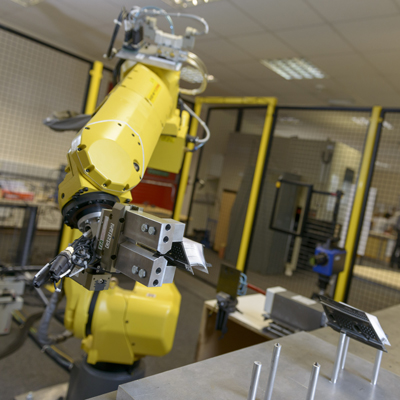The Digital Service Engineering Group aims to develop innovation in modelling, simulation and visualisation to improve the design, manufacturing, in-service and disposal processes for complex long life assets.
The group focuses on using digital technologies and processes to enhance efficiency and effectiveness in through-life engineering. Some of the key areas that we can support include:
- Augmented reality applications for future manufacturing and maintenance systems;
- Virtual prototyping for products and services;
- Modelling and simulation of manufacturing and service, and support in terms of costs, performance, risks and uncertainties;
- Factory layout optimisation;
- Uncertainty quantification for manufacturing and in-service design and delivery;
- AI and machine learning for through-life applications.
Projects can range from small studies investigating the feasibility of new ideas to meet industrial requirements, to large projects developing and validating new or improved modelling, simulation or visualisation methods.
We focus on collaborative R&D projects that aim to develop new, improved and more accurate modelling, simulation and visualisation for decision making at varying levels such as component, process, (sub) system, business unit, enterprise, and/or supply network.
Related areas
The Digital Service Engineering Group works closely with the Degradation Assessment Group.
For more information contact Professor John Erkoyuncu, Director of the Through-life Engineering Services Centre - Digital Service Engineering.
Our people
- Dr John Erkoyuncu
- Dr Maryam Farsi
- Dr Christina Latsou
- Dr Dedy Ariansyah
- Samuel Court
- Bikram Thapa
- Iñigo Fernández Del Amo Blanco
- Alex Grenyer
Our capabilities
The group has over 10 years of experience in digital engineering. The research capabilities in modelling and simulation for manufacturing and through-life engineering are:
- Risk and uncertainty quantification at the early stage of long life contracts/equipment;
- Whole life cost modelling;
- Manufacturing layout optimisation, including discrete event in an immersive environment;
- Optimising maintenance and repair delivery including agent based and discrete event simulation, and system dynamics applications;
- AI and machine learning for diagnosis, maintenance and repair, and remaining useful life;
- Obsolescence management;
- Servitization and organisational transformation;
- Visualisation;
- Augmented reality applications have been developed for deskilling complex tasks, remote collaboration, and training delivery;
- Digital Twins related projects have aimed to build a representation of the physical product and processes in a digital format. This focuses on providing guidance with predicted costs, and may contain real time data about equipment health;
- Virtual reality related projects that we have been involved in have focused on visualising ‘big data’ and for delivering training for assembly and disassembly activities.
Our facilities
A central feature of the Digital Service Engineering Group is leading-edge virtual and augmented reality visualisation and high definition video collaboration that enables us to reach out to an online global audience of industry-based partners.
The lab offers an impressive visualisation suite comprising large projection display with precision infrared tracking, fully immersive head mounted display system and 3D fly sticks, which together enable group collaboration within a virtual world. A team of engineers, for example, may navigate a 3D model, select and manipulate component parts in real time and facilitate decision making at all stages of a product development cycle. The lab offers access to a range of facilities including but not limited to:
- ART Trackpack optical tracking system;
- NVIS ST50 VR/AR headset;
- Flystick2 3D mouse;
- Oculus Rift VR headset;
- Dell NVIDIA Quadro K5000 workstations;
- Double telepresence robot;
- 9-screen NEC video wall;
- Optoma HD projector;
- Dual screen breakout displays;
- Google Glass Explorer;
- Epson Moverio BT-200;
- Makerbot Replicator 2 3D printer;
- DAVID laser scanner.
The digital service engineering theme has a flexible operating system to produce VR models from standard CAD data. We also have facilities to integrate data from discrete event simulation to VR.
Our telepresence hosts up to 500 online participants simultaneously via desktop, tablet or mobile device to facilitate high quality international conferencing, design and training events. Your organisation benefits from consistency of delivery, reduced travel costs, and environmental impact and enhanced employees’ work/life balance and productivity.
Apart from visualisation capabilities we have a range of modelling and simulation software packages available for use such as Witness and AnyLogic.









